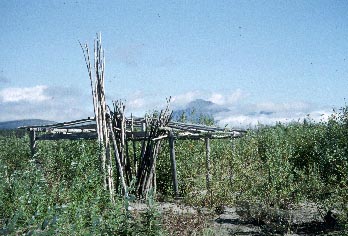Qalugriivik
The Place Where Fish Go Through
Qalugriivik is the Woods family's traditional camp located on the upper Kobuk River. It is the second furthest camp on the Kobuk River from villages down river. I stayed there with the family for one month. Activities at the camp were subsistence such as fishing, hunting and gathering. Other main activities are taking care of 30 race dogs, that have been brought up from Shungnak, and various house chores.





There was never a boring day at the camp. Everyday there was so much to do. One busy day might consists of various subsistence activities. A day starts at 10 O'clock in the morning. After breakfast, people might get ready for seining. Josephine, aana, knows where to go. We seine and come back with a boat full of fish. Women start to cut fish right away. My job was to imiqtuq, pack water, for washing fish after being cut. Then, I hang them for drying. This takes all afternoon till dinner time around 7 or 8 in the evening. After dinner, Sunny, Fred and I may go up river to look for moose, caribou or just for the ride. When we come back to the camp it was usually 3 or 4 in the morning. Next day, it is the same all over again.
Qaaqsaq, seining, is one of the most important activities at the camp.(see photo below) Whitefish and salmon are the two major fishes that are caught for drying. One qaaqsaq might produce up to 400 whitefish in 20 minuites. I experienced qaaqsaq 6 times at camp.

I am going down to Shungnak today. Then tomorrow, I fly back to Fairbanks. Last night, Sunny, Fred and I went way up river. They wanted to look for caribou. We went 48 bends from the camp. As the summer fades in northwest Alaska, it starts to get chilly in the evening. We all dressed up in sweater, ski-pants, and heavy jackets. We packed snack and coffee. About a week ago when we went hunting, Fred shot a black bear. Fred offered me to drive his brand new Honda 75-horsepower jet boat last night. I stood behind the wheel and started to drive. I followed Sunny's hand signal so that I wouldn't hit the bottom of the river. The sky was filled with sunset colors as they painted the Manniluq Mountains. The hugeness and the stillness of the land filled me up. Then I realized the most important thing in my life: cultural anthropology is not needed by these people. It has no meaning to them. They are not subjects but the same human beings and my friends. However, they all expressed interest in wacthing themselves in documentary film. And that's what I would do. After 2 bends Fred took over the wheel. I shouted to Sunny and Fred, "I will never forget what I just felt!" Along the way, we saw a cow moose with a calf, but the Eskimo law prohibits hunting them in August. We floated for awhile and munched down. Sunny told stories about hills, streams and what had happened there. Fred and I, the same age, just listened to him. I am leaving this place, not forever but for awhile.










